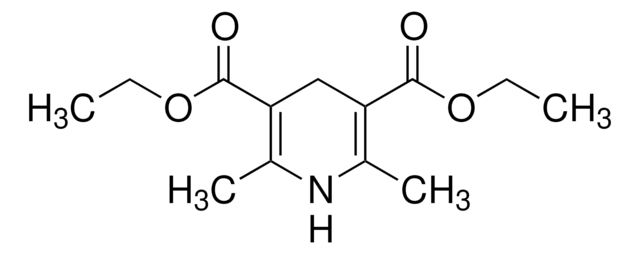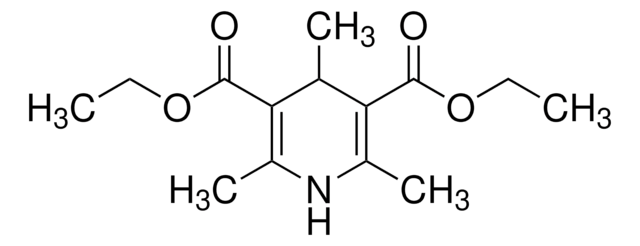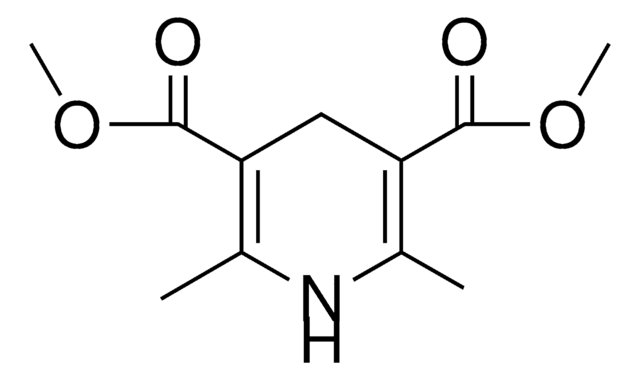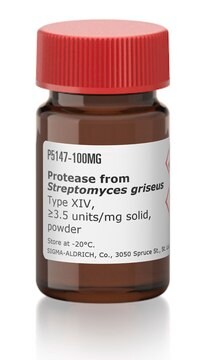Wszystkie zdjęcia(1)
Kluczowe dokumenty
137030
Diethyl 1,4-dihydro-2,4,6-trimethyl-3,5-pyridinedicarboxylate
99%
Synonim(y):
3,5-Dicarbethoxy-1,4-dihydrocollidine, DDC
Zaloguj sięWyświetlanie cen organizacyjnych i kontraktowych
About This Item
Wzór empiryczny (zapis Hilla):
C14H21NO4
Numer CAS:
Masa cząsteczkowa:
267.32
Numer WE:
Numer MDL:
Kod UNSPSC:
12352100
Identyfikator substancji w PubChem:
NACRES:
NA.22
Polecane produkty
Próba
99%
Formularz
powder
mp
130-132 °C (lit.)
ciąg SMILES
CCOC(=O)C1=C(C)NC(C)=C(C1C)C(=O)OCC
InChI
1S/C14H21NO4/c1-6-18-13(16)11-8(3)12(14(17)19-7-2)10(5)15-9(11)4/h8,15H,6-7H2,1-5H3
Klucz InChI
CDVAIHNNWWJFJW-UHFFFAOYSA-N
Zastosowanie
Diethyl 1,4-dihydro-2,4,6-trimethyl-3,5-pyridinedicarboxylate was used to induce Mallory-Denk body formation in mice in vivo.
Działania biochem./fizjol.
Diethyl 1,4-dihydro-2,4,6-trimethyl-3,5-pyridinedicarboxylate blocks the heme synthesis and prevents the induction of hepatic heme oxygenase-1 in mice.
Ta strona może zawierać tekst przetłumaczony maszynowo.
Hasło ostrzegawcze
Warning
Zwroty wskazujące rodzaj zagrożenia
Zwroty wskazujące środki ostrożności
Klasyfikacja zagrożeń
Eye Irrit. 2 - Skin Irrit. 2 - STOT SE 3
Organy docelowe
Respiratory system
Kod klasy składowania
11 - Combustible Solids
Klasa zagrożenia wodnego (WGK)
WGK 3
Temperatura zapłonu (°F)
Not applicable
Temperatura zapłonu (°C)
Not applicable
Środki ochrony indywidualnej
dust mask type N95 (US), Eyeshields, Gloves
Wybierz jedną z najnowszych wersji:
Masz już ten produkt?
Dokumenty związane z niedawno zakupionymi produktami zostały zamieszczone w Bibliotece dokumentów.
Klienci oglądali również te produkty
Volker Mostert et al.
Drug metabolism reviews, 39(2-3), 619-626 (2007-09-06)
Heme oxygenase (HO)-1 is induced by oxidative stress and protects against oxidant injury. We examined the effect of rapid induction of hepatic HO-1 on serum iron level. Serum iron was approximately doubled within 6 h when HO-1 was induced by
Pavel Strnad et al.
Hepatology (Baltimore, Md.), 48(3), 931-942 (2008-08-13)
The cytoplasmic hepatocyte inclusions, Mallory-Denk bodies (MDBs), are characteristic of several liver disorders, including alcoholic and nonalcoholic steatohepatitis. In mice, MDBs can be induced by long-term feeding with 3,5-diethoxycarbonyl-1,4-dihydrocollidine (DDC) for 3 to 4 months or rapidly reformed in DDC-induced
Johanna R Schaub et al.
Nature, 557(7704), 247-251 (2018-05-04)
Transdifferentiation is a complete and stable change in cell identity that serves as an alternative to stem-cell-mediated organ regeneration. In adult mammals, findings of transdifferentiation have been limited to the replenishment of cells lost from preexisting structures, in the presence
Leila Jemail et al.
Scientific reports, 8(1), 6415-6415 (2018-04-25)
Kupffer cells (KCs) are key players in maintaining tissue homeostasis and are involved in various liver diseases. However, the roles of KCs in the pathogenesis of cholangiopathy are largely unknown. We aimed to investigate the precise roles of KCs in
Tohru Itoh et al.
FEBS letters, 583(4), 777-781 (2009-01-29)
In injured livers where hepatocyte growth is severely limited, facultative hepatic stem/progenitor cells, termed oval cells in rodents, are known to emerge and contribute to the regeneration process. Here, we investigated a possible involvement of Wnt signaling during mouse oval
Nasz zespół naukowców ma doświadczenie we wszystkich obszarach badań, w tym w naukach przyrodniczych, materiałoznawstwie, syntezie chemicznej, chromatografii, analityce i wielu innych dziedzinach.
Skontaktuj się z zespołem ds. pomocy technicznej










